Input interpretation

tin (chemical element) | antimony (chemical element) | indium (chemical element)
Periodic table location
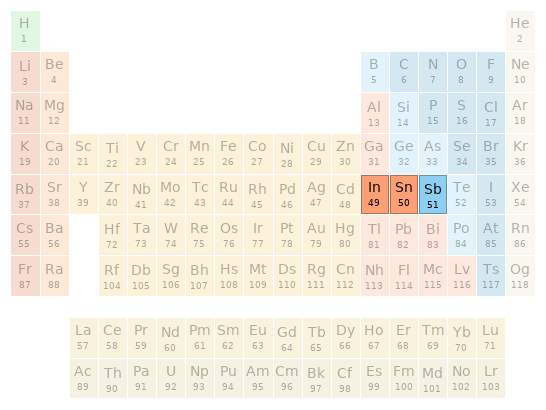
Periodic table location
Images

Images
Basic elemental properties
![| tin | antimony | indium atomic symbol | Sn | Sb | In atomic number | 50 | 51 | 49 short electronic configuration | [Kr]5s^24d^105p^2 | [Kr]5s^24d^105p^3 | [Kr]5s^24d^105p^1 Aufbau diagram | 5p 4d 5s | 5p 4d 5s | 5p 4d 5s block | p | p | p group | 14 | 15 | 13 period | 5 | 5 | 5 atomic mass | 118.71 u | 121.76 u | 114.818 u half-life | (stable) | (stable) | (stable)](../image_source/75003cc29d2c9a4db64219b2258199b3.png)
| tin | antimony | indium atomic symbol | Sn | Sb | In atomic number | 50 | 51 | 49 short electronic configuration | [Kr]5s^24d^105p^2 | [Kr]5s^24d^105p^3 | [Kr]5s^24d^105p^1 Aufbau diagram | 5p 4d 5s | 5p 4d 5s | 5p 4d 5s block | p | p | p group | 14 | 15 | 13 period | 5 | 5 | 5 atomic mass | 118.71 u | 121.76 u | 114.818 u half-life | (stable) | (stable) | (stable)
Thermodynamic properties
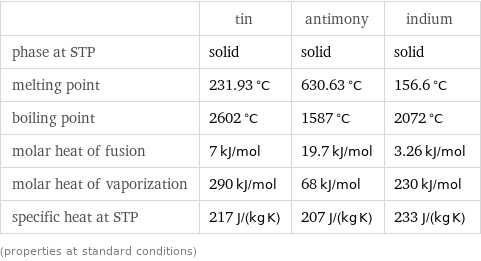
| tin | antimony | indium phase at STP | solid | solid | solid melting point | 231.93 °C | 630.63 °C | 156.6 °C boiling point | 2602 °C | 1587 °C | 2072 °C molar heat of fusion | 7 kJ/mol | 19.7 kJ/mol | 3.26 kJ/mol molar heat of vaporization | 290 kJ/mol | 68 kJ/mol | 230 kJ/mol specific heat at STP | 217 J/(kg K) | 207 J/(kg K) | 233 J/(kg K) (properties at standard conditions)
Material properties

| tin | antimony | indium density | 7.31 g/cm^3 | 6.697 g/cm^3 | 7.31 g/cm^3 liquid density | 6.99 g/cm^3 | 6.53 g/cm^3 | 7.02 g/cm^3 molar volume | 16.24 cm^3/mol | 18.18 cm^3/mol | 15.71 cm^3/mol Mohs hardness | 1.5 (between talc and gypsum) | 3 (≈ calcite) | 1.2 (between talc and gypsum) Brinell hardness | 51 MPa | 294 MPa | 8.83 MPa bulk modulus | 58 GPa | 42 GPa | shear modulus | 18 GPa | 20 GPa | Young's modulus | 50 GPa | 55 GPa | 11 GPa Poisson ratio | 0.36 | | ultimate tensile strength | 220 MPa | 11 MPa | 4 MPa sound speed | 2500 m/s | 3420 m/s | 1215 m/s thermal expansion | 2.2×10^-5 K^(-1) | 1.1×10^-5 K^(-1) | 3.21×10^-5 K^(-1) thermal conductivity | 67 W/(m K) | 24 W/(m K) | 82 W/(m K) (properties at standard conditions)
Electromagnetic properties
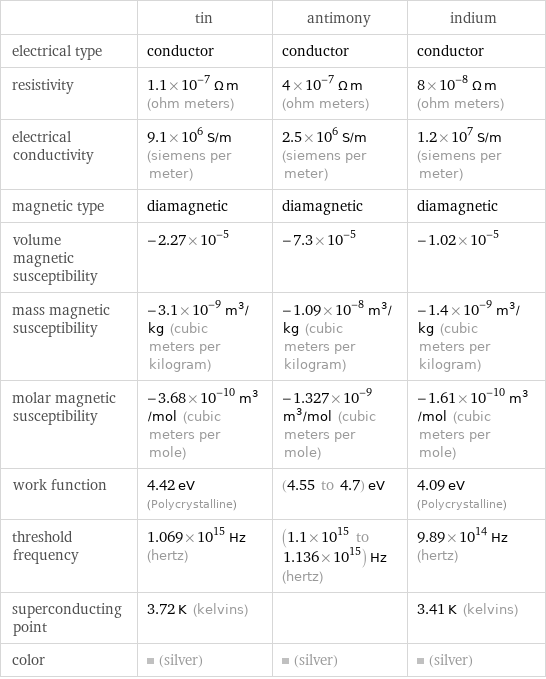
| tin | antimony | indium electrical type | conductor | conductor | conductor resistivity | 1.1×10^-7 Ω m (ohm meters) | 4×10^-7 Ω m (ohm meters) | 8×10^-8 Ω m (ohm meters) electrical conductivity | 9.1×10^6 S/m (siemens per meter) | 2.5×10^6 S/m (siemens per meter) | 1.2×10^7 S/m (siemens per meter) magnetic type | diamagnetic | diamagnetic | diamagnetic volume magnetic susceptibility | -2.27×10^-5 | -7.3×10^-5 | -1.02×10^-5 mass magnetic susceptibility | -3.1×10^-9 m^3/kg (cubic meters per kilogram) | -1.09×10^-8 m^3/kg (cubic meters per kilogram) | -1.4×10^-9 m^3/kg (cubic meters per kilogram) molar magnetic susceptibility | -3.68×10^-10 m^3/mol (cubic meters per mole) | -1.327×10^-9 m^3/mol (cubic meters per mole) | -1.61×10^-10 m^3/mol (cubic meters per mole) work function | 4.42 eV (Polycrystalline) | (4.55 to 4.7) eV | 4.09 eV (Polycrystalline) threshold frequency | 1.069×10^15 Hz (hertz) | (1.1×10^15 to 1.136×10^15) Hz (hertz) | 9.89×10^14 Hz (hertz) superconducting point | 3.72 K (kelvins) | | 3.41 K (kelvins) color | (silver) | (silver) | (silver)
Reactivity

| tin | antimony | indium valence | 4 | 5 | 3 electronegativity | 1.96 | 2.05 | 1.78 electron affinity | 107.3 kJ/mol (kilojoules per mole) | 103.2 kJ/mol (kilojoules per mole) | 28.9 kJ/mol (kilojoules per mole) first ionization energy | 708.6 kJ/mol (kilojoules per mole) | 834 kJ/mol (kilojoules per mole) | 558.3 kJ/mol (kilojoules per mole) ionization energies | 708.6 kJ/mol | 1411.8 kJ/mol | 2943 kJ/mol | 3930.3 kJ/mol | 7456 kJ/mol | 834 kJ/mol | 1594.9 kJ/mol | 2440 kJ/mol | 4260 kJ/mol | 5400 kJ/mol | 10400 kJ/mol | 558.3 kJ/mol | 1820.7 kJ/mol | 2704 kJ/mol | 5210 kJ/mol
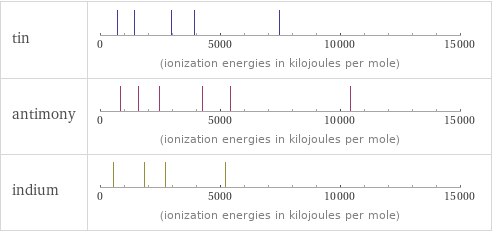
Reactivity
Atomic properties
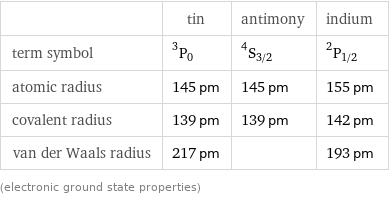
| tin | antimony | indium term symbol | ^3P_0 | ^4S_(3/2) | ^2P_(1/2) atomic radius | 145 pm | 145 pm | 155 pm covalent radius | 139 pm | 139 pm | 142 pm van der Waals radius | 217 pm | | 193 pm (electronic ground state properties)
Abundances
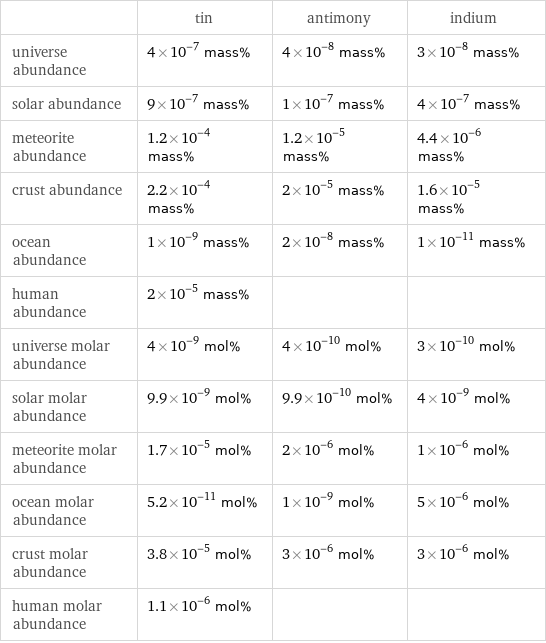
| tin | antimony | indium universe abundance | 4×10^-7 mass% | 4×10^-8 mass% | 3×10^-8 mass% solar abundance | 9×10^-7 mass% | 1×10^-7 mass% | 4×10^-7 mass% meteorite abundance | 1.2×10^-4 mass% | 1.2×10^-5 mass% | 4.4×10^-6 mass% crust abundance | 2.2×10^-4 mass% | 2×10^-5 mass% | 1.6×10^-5 mass% ocean abundance | 1×10^-9 mass% | 2×10^-8 mass% | 1×10^-11 mass% human abundance | 2×10^-5 mass% | | universe molar abundance | 4×10^-9 mol% | 4×10^-10 mol% | 3×10^-10 mol% solar molar abundance | 9.9×10^-9 mol% | 9.9×10^-10 mol% | 4×10^-9 mol% meteorite molar abundance | 1.7×10^-5 mol% | 2×10^-6 mol% | 1×10^-6 mol% ocean molar abundance | 5.2×10^-11 mol% | 1×10^-9 mol% | 5×10^-6 mol% crust molar abundance | 3.8×10^-5 mol% | 3×10^-6 mol% | 3×10^-6 mol% human molar abundance | 1.1×10^-6 mol% | |